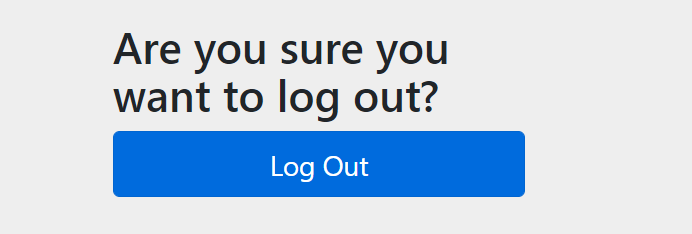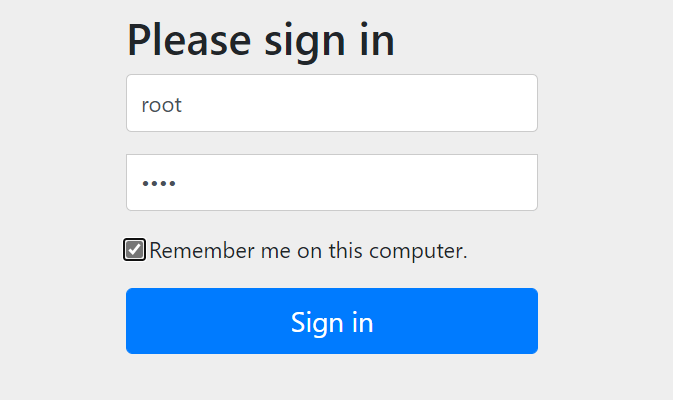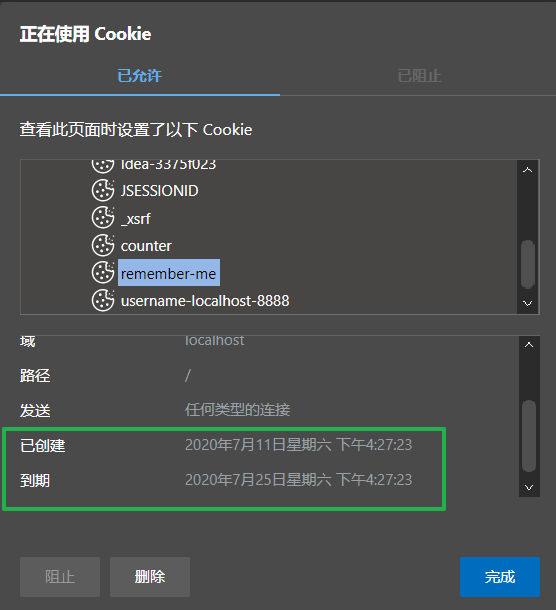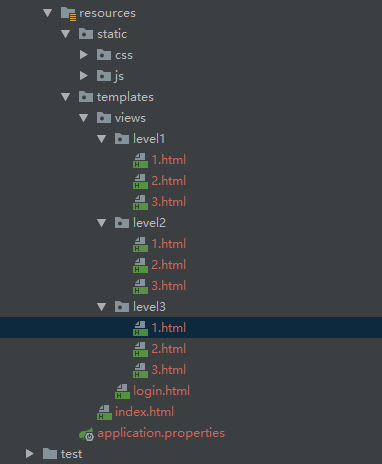SpringBoot + Spring Security 一篇文章快速入门
- 本文收录于Github仓库,欢迎前来 star 呀~ https://github.com/Veal98/CS-Wiki
- 在线阅读地址/更好的阅读体验请移步:https://veal98.gitee.io/cs-wiki/
SpringBoot + Spring Security 一篇文章快速入门
1. SpringSecurity 简介
Spring Security 是针对Spring项目的安全框架,也是Spring Boot底层安全模块默认的技术选型,他可以实现强大的Web安全控制,对于安全控制,我们仅需要引入 spring-boot-starter-security 模块,进行少量的配置,即可实现强大的安全管理。
记住几个类:
WebSecurityConfigurerAdapter:自定义 Security 策略AuthenticationManagerBuilder:自定义认证策略@EnableWebSecurity:开启 WebSecurity 模式
Spring Security的两个主要目标是 “认证” 和 “授权”(访问控制)。
“认证”(Authentication)
身份验证是关于验证您的凭据,如用户名/用户ID和密码,以验证您的身份。
身份验证通常通过用户名和密码完成,有时与身份验证因素结合使用。
“授权” (Authorization)
授权发生在系统成功验证您的身份后,最终会授予您访问资源(如信息,文件,数据库,资金,位置,几乎任何内容)的完全权限。
这个概念是通用的,而不是只在Spring Security 中存在。
2. 实例测试
代码比较简单,就不贴源码了,坑的地方都指出来了,跟着一步步来就没问题,前端素材放在下面了
① 环境搭建
1)创建 SpringBoot 项目,导入 Web 和 Thymeleaf 模块;
2)导入静态资源:
链接:https://pan.baidu.com/s/1D9N9V-lAmKVR0mwhHuOW2w
提取码:rhl8
新建一个 controller 控制界面跳转:
@Controller
public class RouterController {
@RequestMapping({
"/","/index"})
public String index(){
return "index";
}
@RequestMapping("/toLogin")
public String toLogin(){
return "views/login";
}
@RequestMapping("/level1/{id}")
public String level1(@PathVariable("id") int id){
return "views/level1/"+id;
}
@RequestMapping("/level2/{id}")
public String level2(@PathVariable("id") int id){
return "views/level2/"+id;
}
@RequestMapping("/level3/{id}")
public String level3(@PathVariable("id") int id){
return "views/level3/"+id;
}
}
注意先别导入 SpringSecurity 模块,否则会直接跳转到 Login 界面~
② 认证和授权
目前,我们的测试环境,是谁都可以访问的,我们使用 Spring Security 增加上认证 configure(AuthenticationManagerBuilder auth) 和授权 configure(HttpSecurity http) 的功能
Ⅰ 授权
引入 Spring Security 模块
<dependency>
<groupId>org.springframework.bootgroupId>
<artifactId>spring-boot-starter-securityartifactId>
dependency>
编写 Spring Security 配置类
参考官网 Example 81. OAuth2 Login Configuration 登录配置的例子:
新建一个基础配置类:
@EnableWebSecurity // 开启WebSecurity模式
public class SecurityConfig extends WebSecurityConfigurerAdapter {
@Override
protected void configure(HttpSecurity http) throws Exception {
}
}
定制请求的授权规则 configure(HttpSecurity http)
@EnableWebSecurity // 开启WebSecurity模式
public class SecurityConfig extends WebSecurityConfigurerAdapter {
// 授权规则
@Override
protected void configure(HttpSecurity http) throws Exception {
// 首页所有人可以访问
// 其他界面只有对应的角色(权限)才可以访问
http.authorizeRequests().antMatchers("/").permitAll()
.antMatchers("/level1/**").hasRole("vip1")
.antMatchers("/level2/**").hasRole("vip2")
.antMatchers("/level3/**").hasRole("vip3");
}
}
OK,测试一下,我们只能访问首页了,如果点击其他界面,会报错 403 Forbidden:
在 configure(HttpSecurity http) 方法中加入以下配置,开启自动配置的登录功能:
@EnableWebSecurity // 开启WebSecurity模式
public class SecurityConfig extends WebSecurityConfigurerAdapter {
// 授权规则
@Override
protected void configure(HttpSecurity http) throws Exception {
// 首页所有人可以访问
// 其他界面只有对应的角色(权限)才可以访问
http.authorizeRequests().antMatchers("/").permitAll()
.antMatchers("/level1/**").hasRole("vip1")
.antMatchers("/level2/**").hasRole("vip2")
.antMatchers("/level3/**").hasRole("vip3");
// 开启自动配置的登录功能
// 如果没有权限则跳转到 /login 登录页
// /login?error 重定向到这里表示登录失败
http.formLogin();
}
}
测试一下:发现,没有权限的时候,会跳转到登录的页面:

注意,这个登录界面是 Spring Security 自带的默认登录界面
/login, 不是我们自己的
Ⅱ 认证
接下来我们可以定义认证规则,重写 configure(AuthenticationManagerBuilder auth) 方法:
package com.smallbeef.security.config;
import org.springframework.security.config.annotation.authentication.builders.AuthenticationManagerBuilder;
import org.springframework.security.config.annotation.web.builders.HttpSecurity;
import org.springframework.security.config.annotation.web.configuration.EnableWebSecurity;
import org.springframework.security.config.annotation.web.configuration.WebSecurityConfigurerAdapter;
@EnableWebSecurity // 开启WebSecurity模式
public class SecurityConfig extends WebSecurityConfigurerAdapter {
// 认证规则
@Override
protected void configure(AuthenticationManagerBuilder auth) throws Exception {
// 内存数据库
auth.inMemoryAuthentication()
.withUser("smallbeef").password("12345").roles("vip1")
.and()
.withUser("user").password("123").roles("vip2","vip3")
.and()
.withUser("root").password("root").roles("vip1","vip2","vip3");
}
// 授权规则
@Override
protected void configure(HttpSecurity http) throws Exception {
......
}
}
❓ 测试之后会报错:
原因就是我们要将前端传过来的密码进行某种方式加密,否则就无法登录。Spring security 官方推荐的是使用 bcrypt 加密方式。:
@EnableWebSecurity // 开启WebSecurity模式
public class SecurityConfig extends WebSecurityConfigurerAdapter {
// 认证规则
@Override
protected void configure(AuthenticationManagerBuilder auth) throws Exception {
//在内存中定义,也可以在jdbc中去拿
auth.inMemoryAuthentication().passwordEncoder(new BCryptPasswordEncoder())
.withUser("smallbeef").password(new BCryptPasswordEncoder().encode("12345")).roles("vip1")
.and()
.withUser("user").password(new BCryptPasswordEncoder().encode("123")).roles("vip2","vip3")
.and()
.withUser("root").password(new BCryptPasswordEncoder().encode("root")).roles("vip1","vip2","vip3");
}
// 授权规则
@Override
protected void configure(HttpSecurity http) throws Exception {
......
}
}
OK,接下来就可以对应角色权限成功访问了~
③ 权限注销和对应权限的界面显示
Ⅰ 权限注销
开启自动配置的注销的功能:
//定制请求的授权规则
@Override
protected void configure(HttpSecurity http) throws Exception {
....
//开启自动配置的注销的功能
// /logout 注销请求
http.logout();
}
在前端,增加一个注销的按钮:
<div class="right menu">
<a class="item" th:href="@{/login}">
<i class="address card icon">i> 登录
a>
<a class="item" th:href="@{/logout}">
<i class="address card icon">i> 注销
a>
div>
跳转的
/login和/logout界面都是 Spring Security 自带的默认界面。

登录成功后点击注销,注销完毕会跳转到登录页面。
❓ 如果我们想让他注销成功后,依旧可以跳转到首页,该怎么处理呢?
// .logoutSuccessUrl("/"); 注销成功来到首页
http.logout().logoutSuccessUrl("/");
Ⅱ 对应权限的界面显示
接下来,我们的需求就是: 用户没有登录的时候,导航栏上只显示登录按钮,用户登录之后,导航栏上显示登录的用户信息及注销按钮。以及,比如 smallbeef 这个用户,它只有 vip1 功能,那么登录则只显示这 1 个功能,而 vip2 vip3 的功能菜单不显示。这个就是真实的网站情况了~
我们需要结合 thymeleaf 中的一些功能:导入 thymeleaf-extras-springsecurity5
<dependency>
<groupId>org.thymeleaf.extrasgroupId>
<artifactId>thymeleaf-extras-springsecurity5artifactId>
<version>3.0.4.RELEASEversion>
dependency>
修改前端页面:
导入命名空间:
<html lang="en" xmlns:th="http://www.thymeleaf.org" xmlns:sec="http://www.thymeleaf.org/thymeleaf-extras-springsecurity5">
<div class="right menu">
<div sec:authorize="!isAuthenticated()">
<a class="item" th:href="@{/login}">
<i class="address card icon">i> 登录
a>
div>
<div sec:authorize="isAuthenticated()">
<a class="item">
<i class="address card icon">i>
用户名:<span sec:authentication="principal.username">span>
角色:<span sec:authentication="principal.authorities">span>
a>
div>
<div sec:authorize="isAuthenticated()">
<a class="item" th:href="@{/logout}">
<i class="address card icon">i> 注销
a>
div>
div>
![]()
OK,我们继续将下面的角色功能块认证完成:
即在每个需要对应权限才能访问的模块上添加属性sec:authorize="hasRole('vip1')"
<div class="column" sec:authorize="hasRole('vip1')">
<div class="ui raised segment">
<div class="ui">
<div class="content">
<h5 class="content">Level 1h5>
<hr>
<div><a th:href="@{/level1/1}"><i class="bullhorn icon">i> Level-1-1a>div>
<div><a th:href="@{/level1/2}"><i class="bullhorn icon">i> Level-1-2a>div>
<div><a th:href="@{/level1/3}"><i class="bullhorn icon">i> Level-1-3a>div>
div>
div>
div>
div>
<div class="column" sec:authorize="hasRole('vip2')">
<div class="ui raised segment">
<div class="ui">
<div class="content">
<h5 class="content">Level 2h5>
<hr>
<div><a th:href="@{/level2/1}"><i class="bullhorn icon">i> Level-2-1a>div>
<div><a th:href="@{/level2/2}"><i class="bullhorn icon">i> Level-2-2a>div>
<div><a th:href="@{/level2/3}"><i class="bullhorn icon">i> Level-2-3a>div>
div>
div>
div>
div>
<div class="column" sec:authorize="hasRole('vip3')">
<div class="ui raised segment">
<div class="ui">
<div class="content">
<h5 class="content">Level 3h5>
<hr>
<div><a th:href="@{/level3/1}"><i class="bullhorn icon">i> Level-3-1a>div>
<div><a th:href="@{/level3/2}"><i class="bullhorn icon">i> Level-3-2a>div>
<div><a th:href="@{/level3/3}"><i class="bullhorn icon">i> Level-3-3a>div>
div>
div>
div>
div>
运行代码:
④ Remember me
现在的情况,我们只要登录之后,关闭浏览器,再登录,就会让我们重新登录,但是很多网站有一个记住密码的功能,这个该如何实现呢?很简单:
// 授权规则
@Override
protected void configure(HttpSecurity http) throws Exception {
......
//记住我
http.rememberMe();
}
我们再次启动项目测试一下,发现登录页多了一个记住我功能:

⚠ 注意,这个记住我功能是基于 Spring Security 的默认登录界面的,如果是自定义登录界面,需要另行配置,详见下文。
登录之后关闭浏览器,然后重新打开浏览器访问,用户依旧存在。
我们可以查看浏览器的 cookie,默认保留 14 天:

点击注销的时候,Spring security 删除了这个 cookie。
⑤ 定制登录页
Ⅰ 自定义登录页跳转
现在这个登录页面都是 Spring security 默认的,怎么样可以使用我们自己写的 Login 界面呢?
首先,在刚才的登录页配置后面指定 loginpage:
// 授权规则
@Override
protected void configure(HttpSecurity http) throws Exception {
......
http.formLogin().loginPage("/toLogin");
......
}
前端也需要指向我们自己定义的 login 请求
<a class="item" th:href="@{/toLogin}">
<i class="address card icon">i> 登录
a>
login.html 配置提交请求及方式,方式必须为 post:
<form th:action="@{/login}" method="post">
<div class="field">
<label>Usernamelabel>
<div class="ui left icon input">
<input type="text" placeholder="Username" name="username">
<i class="user icon">i>
div>
div>
<div class="field">
<label>Passwordlabel>
<div class="ui left icon input">
<input type="password" name="password">
<i class="lock icon">i>
div>
div>
<input type="submit" class="ui blue submit button"/>
form>
这个请求提交上来,我们还需要验证处理,配置接收登录的用户名和密码的参数:
http.formLogin()
.usernameParameter("username")
.passwordParameter("password")
.loginPage("/toLogin")
.loginProcessingUrl("/login"); // 登陆表单提交请求
Ⅱ Remember me
在登录页增加记住我的多选框:
<input type="checkbox" name="remember"> 记住我
后端验证处理:
// 授权规则
@Override
protected void configure(HttpSecurity http) throws Exception {
......
//记住我
http.rememberMe().rememberMeParameter("remember");
}
运行代码:
Ⅲ 解决注销后 404
如果注销后出现 404 了,就是因为它默认防止 csrf 跨站请求伪造,因为会产生安全问题,我们可以将请求改为 post 表单提交,或者在 Spring security 中关闭 csrf 功能。在授权配置中增加 http.csrf().disable();
// 授权规则
@Override
protected void configure(HttpSecurity http) throws Exception {
......
http.csrf().disable(); // 关闭 csrf 功能:跨站请求伪造,默认只能通过post方式提交logout请求
}
OK,万事大吉
References
- 【狂神说Java】SpringBoot 最新教程IDEA版通俗易懂










